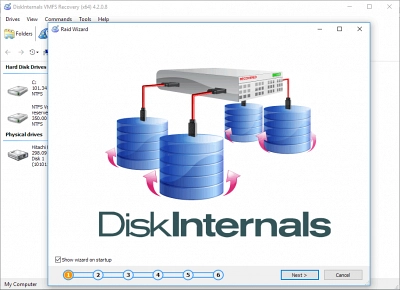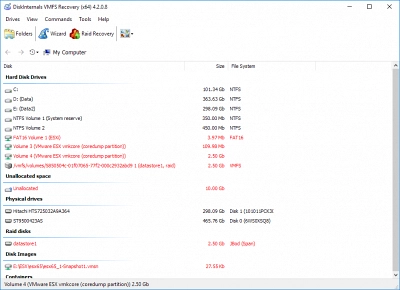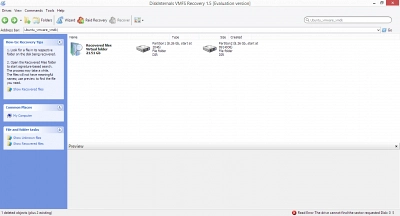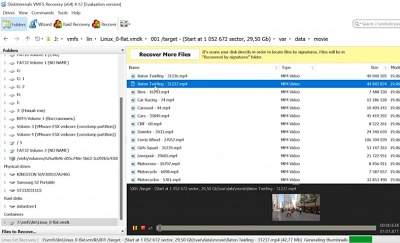Restoring a VMware virtual machine using DiskInternals VMFS Recovery
All the time, you’d hear IT admins and pro PC users talk about “Data Recovery”. Yes, it is that important, regardless of whatever you’re using a computer to do. You can recover files from a regular hard disk drive, you can also recover files from a VMware virtual machine. So, let’s get closer to the subject of today's article.
Virtual machines can be restored either to their original location or to another one. The original hypervisor is used to restore virtual machines by default, and the backup proxy is used.
A virtual machine can be restored to vCloud if the hypervisor is set up to support it.
A restoration procedure may be started from the VM groups page, the Virtual machines page, or the detail page for a particular VM. You have the option to restore the whole VM, employ live recovery, or carry out a live mount action when you start a restoration process for a specific VM from the VM groups page or the Virtual machines page.
Reasons Behind the Need to Recover data from Vmware Disk
There are several reasons why you may need to recover data from a VMware disk:
- Accidental deletion: One of the most common reasons for data recovery is accidental deletion of files or entire VMs. This can happen due to user error, software bugs, or hardware failures.
- Corrupted files: Files can become corrupted due to software errors, hardware issues, or power outages. This can lead to data loss or damage, and may require data recovery to restore the lost files.
- Malware or virus attacks: Malware or virus attacks can cause data loss or corruption by deleting files or altering their contents. Data recovery may be necessary to recover lost or damaged files.
- Hardware failures: Hardware failures such as disk crashes, controller failures, or power surges can cause data loss or corruption. In some cases, data recovery may be necessary to restore the lost files.
- Operating system issues: Operating system issues such as driver conflicts, system crashes, or software updates can cause data loss or corruption. Data recovery may be necessary to recover lost or damaged files.
In any of these situations, it may be necessary to recover data from a VMware disk to restore lost or damaged files. It's important to have a backup and recovery plan in place to minimize the risk of data loss and ensure that critical data can be restored quickly and easily.
Recovery Preparation
Users can recover VMware VMs from a backup. In this case, the user may only modify the value of the VM display name option in the Restore preferences dialog box.
Any user who is linked with the recovery target can restore a VM out of place and choose a recovery target from the Destination list if an admin user specifies the recovery target and associates a user or a user group with the recovery target.
The restoration is unsuccessful if the VM display name matches that of an already-existing VM at the destination.
How to Live Recovery Your VM
Virtual machines (VMs) may be restored and switched up from a backup using the Live Recovery function without having to wait for a complete VM restore. This functionality may be used to swiftly restore a failing virtual machine to production or to confirm that a backup can be used in a disaster recovery situation.
To enable the actions required by the VM, data is restored from the backup as needed, and the entire restore is finished as soon as resources permit. The restoration procedure does not change the backup.
The Live Recovery procedure is as follows:
1. When this option is used during a restoration, the backup's MediaAgent may be utilized throughout the restore process.
2. The restoration procedure exposes the backup to the target ESX server as a network file system (NFS) export rather than reading it.
3. The destination ESX server mounts the NFS export as an NFS datastore.
4. The restoration procedure gets the.vmx and catalog files for the VM when the ESX server can see the NFS datastore.
The.vmx file has been altered to reflect that the NFS datastore's VMDK files may be written to (or the VM can be modified to redirect writes to an alternate datastore).
5. The VM is registered and may be switched on when the VM files are accessible to the NFS datastore.
6. The File Recovery Enabler for Linux handles any read requests for the virtual machine disks, restoring the necessary data to the NFS cache and presenting it to the ESX server.
7. A storage vMotion is started to move the virtual machine to the destination datastore designated for the restoration after the first readings required to make the VM operational.
8. The ESX server unmounts the datastore and unexports the backup after the migration is finished (if there are no other paths exported to the ESX server). The restoration task is indicated as finished after the cleaning is finished.
Recovery Guide
- 1. Go Protect > Virtualization
- 2. Click the hypervisor
- 3. Click action, Restore
- 4. Click Settings > Source list > Copy
- 5.Select Full virtual machine
- 6. Click Restore
- 7. Click Submit.
How Do I Recover VMware Virtual Machine From Backup
While it is possible to restore VMware virtual machines from backup files (VMDK), such recovery won’t go through if the dataset of the VM is deleted. The procedures to recover your VMware VMs from VMDK files – with the main focus on VMs launched on ESXi hostsare explained below:
- You have to access the ESXi Web Client, go to the Storage page, and click on “Datastore browser” on the toolbar.
- In the new window, click “Create directory” and create a new folder for the new virtual machine.
- Import the VMDK and VMX files into this new folder.
- Go to the Virtual Machines page, and click on Create/Register VM on the toolbar.
- On the “Select creation type” page, choose “Register an existing virtual machine” and click the Next button.
- On the next page, select your virtual machines and click Next.
- Click the Finish button and close the Wizard.
- Now, back on the Virtual Machines pace, the newly created VM would appear as a VMX file – all you need to do is to right-click on it, rename it, and power it.
Now that the backup file has been used to create a new VM – with the same properties as the old VM – on your VMware ESXi host, that is the recovery you need. But, using this method doesn’t work all the time; hence, you may want to consider using a third-party tool.
Recover VMware VM with VMFS Recovery
Every other VMware VM recovery option can only restore or back up one single ESXi VM at a time. Therefore, they are not the best solution for enterprise businesses and IT admins that handle multiple VMs.
That said, if you need to recover multiple VMs at a time, you need a professional VMware VM recovery software, and that’s where DiskInternals VMFS Recovery comes in.
Step One

Launch the DiskInternals VMFS Recovery software – the Recovery Wizard will launch automatically, too – select the disk where you had saved the VM file and choose a scanning/recovery mode.
Step Two

You may start with the Fast Recovery mode, which is pretty fast and time-saving. However, if you want to make a wholesome recovery to repair corrupt or damaged files, choose the Full Recovery mode. While the recovery scan is ongoing, DiskInternals VMFS Recovery will automatically examine and structure/fix bad sectors on the disk.
Step Three

Once the scan is complete, the deleted files will be marked with a red asterisk – search carefully and find the VM files you were looking to recover.

DiskInternals VMFS Recovery lets you preview recovered files for free, which means you can preview the files you just recovered to figure out the ones that are more important to re-save to your computer.
Conclusion
The DiskInternals VMFS Recovery is the most reliable tool to use in recovering virtual machine files seamlessly. You can recover hundreds of files at the same time using this tool.
FAQ
Can you recover a deleted virtual machine?
In general, it is not possible to recover a deleted virtual machine unless you have taken specific measures beforehand to ensure its recovery.
If you have taken a backup of the virtual machine, then you may be able to restore it from the backup. Most virtualization platforms offer the ability to take backups of virtual machines, and you should check if you have any backups that can be restored.
Another option is to check if the virtual machine files are still present on the storage device where they were stored. If the files have not been overwritten, then there is a possibility of recovering them using data recovery tools. However, this method is not always reliable, and you may not be able to recover all the data.
It is always recommended to take regular backups of your virtual machines and store them in a secure location. This can help you recover your data in case of accidental deletion or other disasters.
How to recover a VM in VMware?
- Determine the reason for VM failure: Before you can start the recovery process, you need to know what caused the VM to fail in the first place. Check the error messages and logs to identify the issue.
- Identify the backup: Determine which backup you will use to recover the VM. This may be a full backup or a snapshot.
- Shut down the affected VM: If the VM is still running, shut it down gracefully to avoid data loss.
- Restore the VM: In the VMware vSphere Client, navigate to the host or cluster that the VM is on, and select "Actions" > "Deploy OVF Template." Choose the backup file you want to use, and follow the prompts to restore the VM.
- Power on the VM: Once the VM is restored, power it on and ensure that it is working correctly.
- Test the VM: Test the recovered VM to ensure that all the data and applications are functioning as expected.
How do I recover an accidentally deleted VM?
- Check if the VM is in the Recycle Bin: In vSphere Client, navigate to the datastore where the VM was stored, and check if it is in the Recycle Bin. If it is, right-click on the VM and select "Restore."
- Restore from a backup: If the VM is not in the Recycle Bin, you can attempt to restore it from a backup. First, determine if you have a backup of the VM that includes the necessary files. If you do, follow the steps to restore the VM from the backup. This process may vary depending on the backup software you are using.
- Rebuild the VM: If you do not have a backup or cannot restore from one, you may need to rebuild the VM from scratch. This may involve recreating the virtual disks, configuring the VM settings, and reinstalling the operating system and applications.
How do I restore a VM from a datastore?
The instant restore command can be used to restore one or more datastores. With this command, you may go back in time and restore a datastore or datastores together with any related virtual machines that were part of the snapshot backup at a certain period.
How do I restore a VM from a clone?
1. From the navigation pane, go to Manage Protections > Hypervisors > VMware > Restore.
2. In the VMware Restore section, locate the VMDKs in which the target files are stored.
3. Click Options and specify the “destination VM” where you want to create clones of the restored volumes.
How long does a VM restore take?
10 to 30 minutes.
